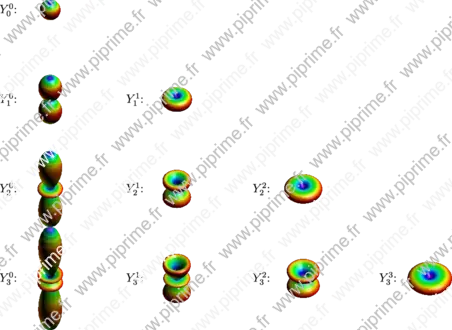Figure Asymptote graph3 -- 018
🔗This picture comes from the Asymptote gallery of topic graph3

The spherical harmonics are the angular portion of the solution to Laplace's equation in spherical coordinates where azimuthal symmetry is not present.
The spherical harmonics are defined by:
where and is the Legendre polynomial.
Source
Show graph3/fig0180.asy on Github.
Generated with Asymptote 3.00-0.
Categories : Examples 3D | Graph3.asy
Tags : #Graph (3D) | #Palette | #Surface | #Shading (3D) | #Spherical harmonics
import palette; import math; import graph3; typedef real fct(real); typedef pair zfct2(real,real); typedef real fct2(real,real); real binomial(real n, real k) { return gamma(n+1)/(gamma(n-k+1)*gamma(k+1)); } real factorial(real n) { return gamma(n+1); } real[] pdiff(real[] p) { // p(x)=p[0]+p[1]x+...p[n]x^n // retourne la dérivée de p real[] dif; for (int i : p.keys) { if(i != 0) dif.push(i*p[i]); } return dif; } real[] pdiff(real[] p, int n) { // p(x)=p[0]+p[1]x+...p[n]x^n // dérivée n-ième de p real[] dif={0}; if(n >= p.length) return dif; dif=p; for (int i=0; i < n; ++i) dif=pdiff(dif); return dif; } fct operator *(real y, fct f) { return new real(real x){return y*f(x);}; } zfct2 operator +(zfct2 f, zfct2 g) {// Défini f+g return new pair(real t, real p){return f(t,p)+g(t,p);}; } zfct2 operator -(zfct2 f, zfct2 g) {// Défini f-g return new pair(real t, real p){return f(t,p)-g(t,p);}; } zfct2 operator /(zfct2 f, real x) {// Défini f/x return new pair(real t, real p){return f(t,p)/x;}; } zfct2 operator *(real x,zfct2 f) {// Défini x*f return new pair(real t, real p){return x*f(t,p);}; } fct fct(real[] p) { // convertit le tableau des coefs du poly p en fonction polynôme return new real(real x){ real y=0; for (int i : p.keys) { y += p[i]*x^i; } return y; }; } real C(int l, int m) { if(m < 0) return 1/C(l,-m); real OC=1; int d=l-m, s=l+m; for (int i=d+1; i <=s ; ++i) OC *= i; return 1/OC; } int csphase=-1; fct P(int l, int m) { // Polynôme de Legendre associé // http://mathworld.wolfram.com/LegendrePolynomial.html if(m < 0) return (-1)^(-m)*C(l,-m)*P(l,-m); real[] xl2; for (int k=0; k <= l; ++k) { xl2.push((-1)^(l-k)*binomial(l,k)); if(k != l) xl2.push(0); } fct dxl2=fct(pdiff(xl2,l+m)); return new real(real x){ return (csphase)^m/(2^l*factorial(l))*(1-x^2)^(m/2)*dxl2(x); }; } zfct2 Y(int l, int m) {// http://fr.wikipedia.org/wiki/Harmonique_sph%C3%A9rique#Expression_des_harmoniques_sph.C3.A9riques_normalis.C3.A9es return new pair(real theta, real phi) { return sqrt((2*l+1)*C(l,m)/(4*pi))*P(l,m)(cos(theta))*expi(m*phi); }; } real xyabs(triple z){return abs(xypart(z));} size(16cm); currentprojection=orthographic(0,1,1); zfct2 Ylm; triple F(pair z) { // real r=0.75+dot(0.25*I,Ylm(z.x,z.y)); // return r*expi(z.x,z.y); real r=abs(Ylm(z.x,z.y))^2; return r*expi(z.x,z.y); } int nb=4; for (int l=0; l < nb; ++l) { for (int m=0; m <= l; ++m) { Ylm=Y(l,m); surface s=surface(F,(0,0),(pi,2pi),60); s.colors(palette(s.map(xyabs),Rainbow())); triple v=(-m,0,-l); draw(shift(v)*s); label("$Y_"+ string(l) + "^" + string(m) + "$:",shift(X/3)*v); } }